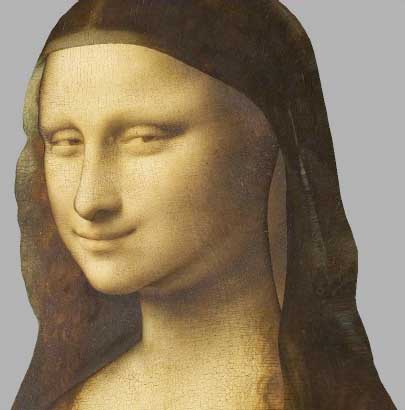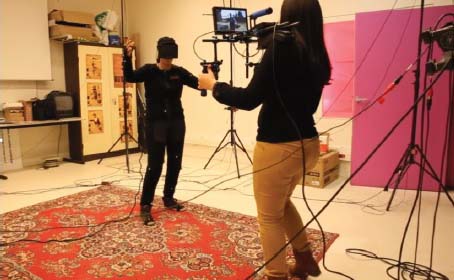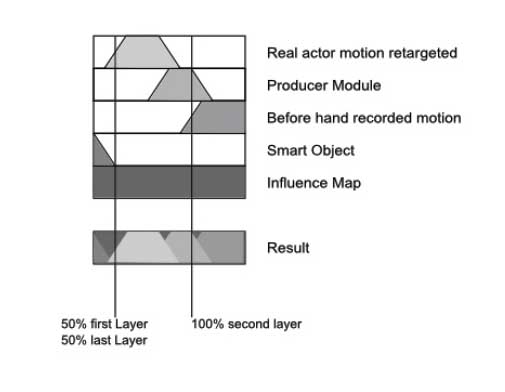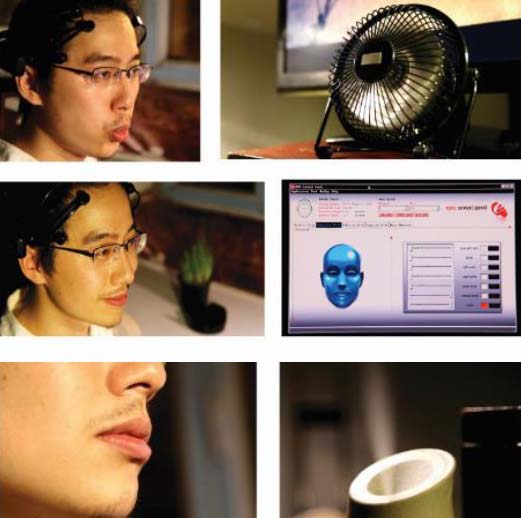Art at Laval Virtual: the germs of a new generation?

Living Joconde 3D model...
If digital art has now found a sort of maturity, with both fresh twigs and deep roots presented in several galleries and major art shows ( see our March post about Art Paris). At Laval Virtual (April), we feel the emergence of something quite different en in the laboratories and some new production structures.
More than properly "works" we have here are projects, growing progressively from conceptual germs to complex technical assemblies. Let's limit us to some of them : Living Joconde, Outilnum, Dolmens, an unnamed techno-philosophical Chinese device, and La chambre de Kristopher.
Living Joconde: high definition and neuronal net
The Living Joconde project is led by Jean-Claude Heudin and Florent Aziosmanoff at Leonard de Vinci "universitary pole". Central to the project is "a bio-inspired engine", coming in straight line from Aziosmanoff's experiences at the Cube art center, notably with Aibo robot dogs, and expressed in his book Living Art (2010. See our comments about emotion).

... and with new emotions for Mona Lisa.
But his idea of a "behavior engine" is now expanded in a sophisticated emotion engine. It draws notably on the Lövheim cube of emotions, and will be animated by a neuronal net. Besides, the interface is based on a very high definition picture of the original Joconde, provided by the Louvre's Museum. This picture will be graphically animated to express the emotional state of the living Mona Lisa (head position, eye movements, etc.) and a kinect module to perceive the spectators attitudes. Such a project is nowadays possible due to the wide range of open source tools. It nevertheless demands the cooperation of several computer geeks. The team, at present, includes Marc Bellan, Fabrice Houlné, Emanuel Perotti, Patricia Gallot-Lavallée and several students. The work will be shown for the first time at Futur en Seine (11-21 june 2015).
Outlinum: virtual camera, goggles, autonomous agents

Outilnum: sophisticated tools for the actors as for the cameraman.
Outilnum is an aid to cinema production. Here also, past research brings bases, with the SCP Camera or Xavier Gouchet, Rémi Quittard and Nicolas. Serickoff (. See a short presentation (PDF)). "It combines a real-time montage interface and an immersive device. It provides to film-maker or camera operator an easy tool to set up their work or previsualization. User can activate actors animations, record the virtual world, and edit sequences before exporting them to a 3D software".
The new project adds googles for the human actors, so they can see themselves as they look in the virtual environment. The complexity reaches new heights, with humans (actors and cameramen) immersed into the virtual work, where virtual characters also play their role.
That demands also a sophiticatd "decisional module", to "maintain the adaptability of the virtual agents in an unstable environment" and "keep the balance between autonomy and actor control", all that framed within a "behavioral layer".

Outilnum: the behavioral layer for the decisional module.
Dolmens, neo-post-modernist?
The Dolmens project, by Dimitrios Batras and Thomas Morisset seems at present to be a pure reflection work, without material implementation. But it intends to dig even deeper in concepts, be it only with its title : Development and ontologies of machines and digital spaces (in French : Développement et ontologie de Machines et d'Espaces Numériques). Note that it associates three research labs, EA 4010 (Paris 8 university), Ensadlab (Ecole nationale des Arts décoratifs) and Centre Victor Basch (Paris 4 University).
Let's quote their paper in Laval virtual: "Dolmens aims to blur the distinction between input and output and seeks to craft a space in which the digital elements of the space and the space itself would have an appreciable degree of autonomy". On this way, we are also taken to to blur the distinction between art, science and philosophy. Not the easy wy, and perhaps typically "French School". But why not ?
Huang: odors, brainwaves and Chinese philosophy

Huang : wind, smile and olfactory interaction.
Anyway, China is also crossing the borders, with a communication of which the mere title raises the stakes high: "Creation methodology of interactive art installation based on philosophy-understanding projection: recreation of traditional chinese painting" (Huang is presently working at Paris 8). Here we have a concrete implementation of the concepts. It combines a computer ant its screen, odor diffusers and a neuroheased (Epoc). The physical connectivity uses an Arduino cart.
A Laval also, Judith Guez (preparing an PhD in Paris 8 Uniersity) showed its virtual world project, with Goggles and a sort of torch as interactive input.
The germs of a new generation in digital art?
These examples, most of them selected for Laval by Alain Lioret (Paris 8), share some features:
- they draw on more than a decade of experiences in the field, on the borders of art, science and philosophy,
- they manage to combine diverse and complex technologies due to the availability of cheap, open and comparatively easy to use technologies,
- they are developed by teams more than by individual artists,
- they let foresee that digital artists of tomorrow will reach levels of complexity clearly higher than the present generation of artists, of which we have described the success .
And, that will call for new creation processes and structures.
And to open even wider the skylines, we found in the show's bookshop three stiumating books:
- Mixed Reality (Merging Real and Virtual Words), edited by Yuichi Ohta and Hideyuki Tamura (Springer 1999),
- Storyworlds across Media (Toward a Media-Conscious Narratology), eidte by Marie-Laure Ryan and Jan-Noël Thon (University of Nebraska Press, 2014),
- and the most reflexion stirring, The Uncanny Valley (in games and animation), by Angela Tinwell (CRC Press 2015), which unveils the high complexity of emotions and emotional exchanges with machines.